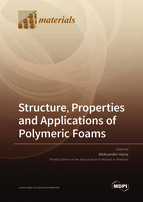Structure, Properties and Applications of Polymeric Foams
A special issue of Materials (ISSN 1996-1944). This special issue belongs to the section "Advanced Composites".
Deadline for manuscript submissions: closed (31 December 2020) | Viewed by 36613
Special Issue Editor
Interests: polymer composites; reactive processing; lignocellulose fillers; filler modification; recycling; waste management; polyurethane foams
Special Issues, Collections and Topics in MDPI journals
Special Issue Information
Dear Colleagues,
The journal Materials is preparing a Special Issue entitled “Structure, Properties and Applications of Polymeric Foams”.
Foaming of polymeric materials enables weight reduction, very important from the economic point of view, but most of all, it should be considered as an excellent means to provide new properties to various polymeric materials. Permanent developments in foaming technologies allow manufacturing of foams with micro- and even nano-sized pores, expanding the already very wide range of their applications. Except for the most conventional applications, which include damping materials, thermal and acoustic insulation, packaging materials or absorbents, applications in catalysis, fuel cells, tissue engineering, and electromagnetic shielding, often associated with nanocellular structures, have become more and more popular.
Moreover, having in mind the ongoing trends and law regulations, it is important to remember the environmental impact of polymeric foams. Recent technological developments often involve biodegradability of foams, application of environmentally friendly raw materials, and innovative recycling methods.
Because of the richness of potential innovations and future developments, the Editors are pleased to launch this Special Issue and invite researchers to contribute their original research papers and reviews on the structure, performance, and applications of polymeric foams.
Topics include:
- Innovations in physical and chemical foaming methods;
- Thermoplastic and thermosetting polymeric foams and composites;
- Polymeric foams based on renewable raw materials;
- Structure–property relationships of polymeric foams;
- Insulation properties of polymeric foams;
- Novel applications of polymeric foams;
- Reduction of foams’ environmental impact;
- Biodegradable and sustainable polymeric foams;
- Recycling of polymeric foams.
Dr. Aleksander Hejna
Guest Editor
Manuscript Submission Information
Manuscripts should be submitted online at www.mdpi.com by registering and logging in to this website. Once you are registered, click here to go to the submission form. Manuscripts can be submitted until the deadline. All submissions that pass pre-check are peer-reviewed. Accepted papers will be published continuously in the journal (as soon as accepted) and will be listed together on the special issue website. Research articles, review articles as well as short communications are invited. For planned papers, a title and short abstract (about 100 words) can be sent to the Editorial Office for announcement on this website.
Submitted manuscripts should not have been published previously, nor be under consideration for publication elsewhere (except conference proceedings papers). All manuscripts are thoroughly refereed through a single-blind peer-review process. A guide for authors and other relevant information for submission of manuscripts is available on the Instructions for Authors page. Materials is an international peer-reviewed open access semimonthly journal published by MDPI.
Please visit the Instructions for Authors page before submitting a manuscript. The Article Processing Charge (APC) for publication in this open access journal is 2600 CHF (Swiss Francs). Submitted papers should be well formatted and use good English. Authors may use MDPI's English editing service prior to publication or during author revisions.
Keywords
- Polymeric foams
- Cellular polymers
- Polymer composites
- Structure–property relationships
- Cellular structure
- Foaming technologies
- Foaming agents
- Insulation properties
- Recycling
- Biodegradable polymers







